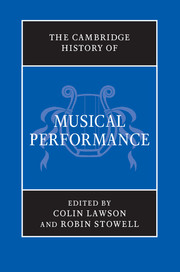Book contents
- Frontmatter
- PART I PERFORMANCE THROUGH HISTORY
- PART II PRE-RENAISSANCE PERFORMANCE
- PART III PERFORMANCE IN THE RENAISSANCE (C. 1430–1600)
- PART IV PERFORMANCE IN THE SEVENTEENTH CENTURY
- PART V PERFORMANCE IN THE ‘LONG EIGHTEENTH CENTURY’
- PART VI PERFORMANCE IN THE NINETEENTH CENTURY
- PART VII THE TWENTIETH CENTURY AND BEYOND
- 28 Musical performance in the twentieth century and beyond: an overview
- 29 Vocal performance in the twentieth century and beyond
- 30 Instrumental performance in the twentieth century and beyond
- 31 Case study: Karlheinz Stockhausen, Gruppen für drei Orchester
- PART VIII
- Index
28 - Musical performance in the twentieth century and beyond: an overview
from PART VII - THE TWENTIETH CENTURY AND BEYOND
Published online by Cambridge University Press: 28 March 2012
- Frontmatter
- PART I PERFORMANCE THROUGH HISTORY
- PART II PRE-RENAISSANCE PERFORMANCE
- PART III PERFORMANCE IN THE RENAISSANCE (C. 1430–1600)
- PART IV PERFORMANCE IN THE SEVENTEENTH CENTURY
- PART V PERFORMANCE IN THE ‘LONG EIGHTEENTH CENTURY’
- PART VI PERFORMANCE IN THE NINETEENTH CENTURY
- PART VII THE TWENTIETH CENTURY AND BEYOND
- 28 Musical performance in the twentieth century and beyond: an overview
- 29 Vocal performance in the twentieth century and beyond
- 30 Instrumental performance in the twentieth century and beyond
- 31 Case study: Karlheinz Stockhausen, Gruppen für drei Orchester
- PART VIII
- Index
Summary
Nineteenth-century legacies
For the purpose of considering musical performance, at least, it is now useful to conceive of the ‘long’ twentieth century, since the cultural, technological and economic forces that shaped performance in that century have their roots in practices that arose in the latter part of the nineteenth century. This is particularly true of the impact of sound-recording technology, which so profoundly changed the nature of performance in nearly all genres and contexts throughout the twentieth century. Undoubtedly, for present purposes, Edison's invention of the phonograph in 1877 marks the beginning of the long twentieth century. It is still perhaps a little too early, and we are at this point too close to it, to be sure where it might be seen to end, although some speculation is offered below.
The impact of recording technology is thus a recurring theme in this chapter, but there are other overarching trends also worthy of note. Closely intertwined with the development of the new technology was the rise of those culture industries that sought to exploit it. Sound recording allowed musical performances to be commodified, and thus packaged, distributed and sold around the world in large quantities. Record companies soon realised there were substantial profits to be made if the right market could be found for the right artist. Successful sales ensured that both the companies themselves and a small number of high-profile performers became increasingly wealthy as the century progressed. But many performers benefited financially to some degree from the income generated by sales of recordings, particularly those in the West, where the larger and more successful record companies were usually based.
- Type
- Chapter
- Information
- The Cambridge History of Musical Performance , pp. 723 - 751Publisher: Cambridge University PressPrint publication year: 2012



